Students must practice these Maths 1B Important Questions TS Inter 1st Year Maths 1B Tangent and Normal Important Questions to help strengthen their preparations for exams.
TS Inter 1st Year Maths 1B Tangent and Normal Important Questions
Question 1.
Find the slope of the tangent to the curve y = 5x2 at the point (-1, 5). [May ’04]
Solution:
Given, the equation of the curve is y = 5x2
Differentiating on both sides with respect to ‘x’
\(\frac{\mathrm{dy}}{\mathrm{dx}}\) = 5(2x) = 10x
∴ Slope of the tangent at P(-1, 5) is m = \(\left(\frac{d y}{d x}\right)_P\)
= 10(-1)
= -10
Question 2.
Find the equations of the tangent and the normal to the curve y = 5x4 at the point (1, 5). [May ’15 (AP), ’10, ’07]
Solution:
Given, the equation of the curve is y = 5x4
Differentiating on both sides with respect to ‘x’
\(\frac{\mathrm{dy}}{\mathrm{dx}}\) = 5 . 4x3 = 20x3
Slope of tangent at P(1, 5) is m = \(\left(\frac{d y}{d x}\right)_P\)
= 20(1)3
= 20
The equation of the tangent at P is y – y1 = m(x – x1)
y – 5 = 20(x – 1)
y – 5 = 20x – 20
20x – y – 15 = 0
The equation of normal at P is y – y1 = \(\frac{-1}{m}\) (x – x1)
y – 5 = \(\frac{-1}{20}\) (x – 1)
20y – 100 = -x + 1
x + 20y – 101 = 0
![]()
Question 3.
Find the equations of the tangent and the normal to the curve y4 = ax3 at (a, a). [May ’13]
Solution:
Given the equation of the curve is y4 = ax3
Differentiating on both sides with respect to ‘x’

Equation of tangent at P(a, a) is y – y1 = m(x – x1)
y – a = \(\frac{3}{4}\)(x – a)
4y – 4a = 3x – 3a
3x – 4y + a = 0
Equation of normal at P (a, a) is y – y1 = \(\frac{-1}{m}\) (x – x1)
y – a = \(\frac{-1}{\frac{3}{4}}\) (x – a)
3y – 3a = 4x + 4a
4x + 3y – 7a = 0
Question 4.
II Show that the tangent at any point ‘θ’ on the curve x = c sec θ, y = c tan θ is y sin θ = x – c cos θ. [Mar. ’19 (TS)]
Solution:
Given that x = c sec θ
Differentiating on both sides with respect to ‘θ’.
\(\frac{d x}{d \theta}\) = c sec θ tan θ
and y = c tan θ
Differentiating on both sides with respect to ‘θ’
\(\frac{d y}{d \theta}\) = c sec2θ
Now,


y sin θ cos θ – c sin2θ = x cos θ – c
y sin θ cos θ – c sin2θ + c = x cos θ
y sin θ cos θ + c(1 – sin2θ) = x cos θ
y sin θ cos θ + c cos2θ = x cos θ
y sin θ + c cos θ = x
y sin θ = x – c cos θ
Question 5.
Find the equations of tangent and the normal to the curve y = x2 – 4x + 2 at the point (4, 2).
Solution:
Given equation of the curve is y = x2 – 4x + 2 ……….(1)
Let given point be P(x, y) = (4, 2)
Differentiating (1) on both sides with respect to ‘x’
\(\frac{d y}{d x}\) = 2x – 4
Slope of the tangent at P is m = \(\left(\frac{\mathrm{d} y}{\mathrm{dx}}\right)_{\mathrm{P}}\)
m = 2(4) – 4 = 4
The equation of the tangent at P is y – y1 = m(x – x1)
y – 2 = 4(x – 4)
y – 2 = 4x – 16
4x – y – 14 = 0
Equation of normal at P is y – y1 = \(\frac{-1}{m}\) (x – x1)
y – 2 = \(\frac{-1}{m}\) (x – 4)
4y – 8 = -x + 4
x + 4y – 12 = 0
![]()
Question 6.
Show that the length of the subnormal at any point on the curve y2 = 4ax is a constant. [Mar. ’13 (Old), ’11, ’05; May ’09]
Solution:
Given, the equation of the curve is y2 = 4ax
Differentiating on both sides with respect to ‘x’
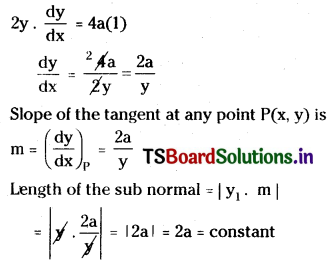
∴ The length of the subnormal at any point (x, y) on the curve is a constant.
Question 7.
Show that the length of the subtangent at any point on the curve y = ax (a > 0) is a constant.
Solution:
Given, the equation of the curve is y = ax
Differentiating on both sides with respect to ‘x’
\(\frac{\mathrm{dy}}{\mathrm{dx}}\) = ax log a
The slope of the tangent at any point P(x, y) is

∴ The length of the subtangent at any point P(x, y) on the curve is a constant.
Question 8.
Show that the square of the length of sub tangent at any point on the curve by2 = (x + a)3 (b ≠ 0) varies with the length of the subnormal at that point.
Solution:
Given, equation of the curve is by2 = (x + a)3
Differentiating on both sides with respect to ‘x’


∴ (length of subtangent)2 ∝ (length of the subnormal).
Question 9.
Find the lengths of sub tangent and subnormal at a point on the curve y = b sin(\(\frac{x}{a}\)). [Mar. ’16 (TS); May ’05]
Solution:
Given equation of the curve is y = b sin(\(\frac{x}{a}\))
Differentiating on both sides with respect to ‘x’

Question 10.
Show that at any point (x, y) on the curve y = \(b e^{x / a}\), the length of the subtangent is a constant and the length of the subnormal is \(\frac{\mathbf{y}^2}{a}\). [Mar. ’18 (TS); May ’12; Mar. ’10]
Solution:
Given equation of the curve is y = \(b e^{x / a}\)
Differentiating on both sides with respect to ‘x’


![]()
Question 11.
Find the lengths of normal and subnormal at a point on the curve y = \(\frac{a}{2}\left[e^{\frac{x}{a}}+e^{\frac{-x}{a}}\right]\). [Mar. ’13]
Solution:
Given equation of the curve is y = \(\frac{a}{2}\left[e^{\frac{x}{a}}+e^{\frac{-x}{a}}\right]\)
y = a cosh(\(\frac{x}{a}\))
Differentiating on both sides with respect to ‘x’

Question 12.
Show that the tangent at P(x1, y1) on the curve √x + √y = √a is \(\mathrm{y}_1 \mathrm{y}^{-1 / 2}+\mathrm{xx}_1^{-1 / 2}\) = \(a^{1 / 2}\). [May ’15 (AP), ’04]
Solution:
Given the equation of the curve is √x + √y = √a ……….(1)
Since the point P(x1, y1) lies on the curve (1) then √x1 + √y1 = √a ……….(2)
Differentiating (1) on both sides with respect to ‘x’

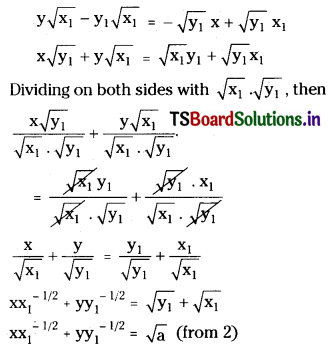
Which is a required equation of a tangent.
Question 13.
If the tangent at any point on the curve \(x^{2 / 3}+y^{2 / 3}=a^{2 / 3}\) intersects the coordinate axes in A and B, then show that the length AB is a constant. [Mar. ’19 (TS); Mar. ’15 (TS), ’14, ’13, ’08, ’07, ’05, ’03; May ’10]
Solution:
Given equation of the curve is \(x^{2 / 3}+y^{2 / 3}=a^{2 / 3}\)
Differentiating on both sides with respect to ‘x’


AB2 = a2
⇒ AB = a (constant)
∴ The length AB is a constant.
Question 14.
If the tangent at any point P on the curve xm yn = am+n (mn ≠ 0) meets the coordinate axes in A, B, then show that AP : BP is a constant. [Mar. ’10; May ’08, ’06]
Solution:
Given the equation of the curve is xm yn = am+n
Differentiating on both sides with respect to ‘x’



Question 15.
At any point, ‘t’ on the curve x = a (t + sin t), y = a(1 – cos t), find the lengths of a tangent, normal, subtangent, and subnormal. [Mar. ’18 (AP)]
Solution:
Given that x = a(t + sin t)
Differentiating on both sides with respect to ‘t’



![]()
Question 16.
(i) Find the angle between the curves xy = 2 and x2 + 4y = 0. [Mar. ’17 (AP); May ’13, ’11]
(ii) Define the angle between the curves. [May ’11]
Solution:
(i) Given, the equations of the curves are
xy = 2 …….(1)
x2 + 4y = 0 ………(2)
From (1), y = \(\frac{2}{x}\)
Substituting in equation (2)


(ii) Angle between two curves: If two curves intersect at a point P and the tangents at P for both curves exists then the angle between the tangents at P is called the angle between the curves at P.
Question 17.
Show that the curves y2 = 4(x + 1) and y2 = 36(9 – x) intersect orthogonally. [Mar. ’13 (old), ’11, ’09, ’08, ’06, ’02; May ’15 (AP), ’05]
Solution:
Given curves are
y2 = 4(x + 1) ………(1)
y2 = 36(9 – x) ……..(2)
From (1) and (2)
4(x + 1) = 36(9 – x)
x + 1 = 81 – 9x
10x = 80
x = 8
If x = 8,
y2 = 4(8 + 1) = 4(9) = 36
y = ±6
∴ Required points are P(8, 6), Q(8, -6)
Differentiating (1) on both sides with respect to ‘x’
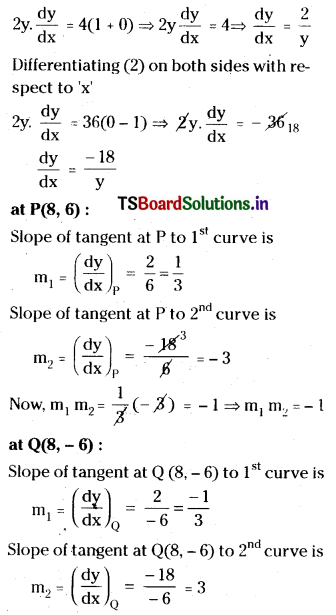
Now, m1m2 = \(\frac{-1}{3}\)(3) = -1
∴ m1m2 = -1
Since, m1m2 = -1, the two curves cut each other orthogonally.
Question 18.
Find the angle between the curves y2 = 4x and x2 + y2 = 5. [Mar. ’16 (AP), ’12; May ’07]
Solution:
Given, the equations of the curves are
y2 = 4x ……..(1)
x2 + y2 = 5 ……..(2)
Substitute equation (1) with equation (2)
x2 + 4x = 5
x2 + 4x – 5 = 0
x2 + 5x – x – 5 = 0
x(x + 5) – 1(x + 5) = 0
(x + 5) (x – 1) = 0
x + 5 = 0 (or) x – 1 = 0
x = -5 (or) x = +1
If x = -5, from (1)
y2 = 4(-5)
y2 = -20 ∉ R
If x = 1, from (1)
y2 = 4(1)
y2 = 4
y = √4 = ±2
∴ Required point are P(1, 2), Q(1, -2)


![]()
Question 19.
Find the angle between the curves x2 + 3y = 3 and x2 – y2 + 25 = 0. [May ’03]
Solution:
Given, the equations of the curves are
x2 + 3y = 3 …….(1)
x2 – y2 + 25 = 0 …….(2)
From (1),
x2 + 3y = 3
x2 = 3 – 3y
Substituting in equation (2)
3 – 3y – y2 + 25 = 0
-y2 – 3y + 28 = 0
y2 + 3y – 28 = 0
y2 + 7y – 4y – 28 = 0
y(y + 7) – 4(y + 7) = 0
(y + 7)(y – 4) = 0
y + 7 = 0 (or) y – 4 = 0
y = -7 (or) y = 4
If y = -7,
x2 = 3 – 3(-7)
= 3 + 21
x2 = 24
x = ±2√6
If y = 4,
x2 = 3 – 3(4)
= 3 – 12
= -9 ∉ R
∴ Required points are P(2√6, -7), Q(-2√6, -7)
Differentiating (1) on both sides with respect to ‘x’



Question 20.
Find the angle between the curves 2y2 – 9x = 0 and 3x2 + 4y = 0 (in the 4th quadrant). [May ’09]
Solution:
Given, the equations of the curves are
2y2 – 9x = 0 ……..(1)
3x2 + 4y = 0 ………(2)
From (1), 2y2 = 9x
x = \(\frac{2 y^2}{9}\)
Substituting in equation (2)


Question 21.
Find the angle between the curves y2 = 8x and 4x2 + y2 = 32. [Mar. ’18 (AP); May ’12]
Solution:
Given, the equations of the curves are
y2 = 8x ……..(1)
4x2 + y2 = 32 ………(2)
Substituting y2 = 8x in equation (2)
4x2 + 8x = 32
4x2 + 8x – 32 = 0
x2 + 2x – 8 = 0
x2 + 4x – 2x – 8 = 0
x(x + 4) – 2(x + 4) = 0
(x + 4) (x – 2) = 0
x + 4 = 0 (or) x – 2 = 0
x = -4 (or) x = 2
If x = -4,
y2 = 8(-4) = -32 ∉ R
If x = 2,
y2 = 8(2) = 16
y = ±4
∴ Required point are P(2, 4), Q(2, -4).
Differentiating (1) on both sides with respect to ‘x’
2y . \(\frac{d y}{d x}\) = 8
y . \(\frac{d y}{d x}\) = 4
\(\frac{d y}{d x}=\frac{4}{y}\)
Differentiating (2) on both sides with respect to ‘x’
4(2x) + 2y . \(\frac{d y}{d x}\) = 0
8x + 2y . \(\frac{d y}{d x}\) = 0


Question 22.
Show that the curves 6x2 – 5x + 2y = 0 and 4x2 + 8y2 = 3 touch each other at \(\left(\frac{1}{2}, \frac{1}{2}\right)\). [Mar. ’15 (AP), ’10; May ’13 (old)]
Solution:
Given, the equations of the curves are
6x2 – 5x + 2y = 0 ……….(1)
4x2 + 8y2 = 3 ………(2)
Let the given point P = \(\left(\frac{1}{2}, \frac{1}{2}\right)\)
Differentiating (1) on both sides with respect to ‘x’


∴ m1 = m2
∴ The curves 6x2 – 5x + 2y = 0, 4x2 + 8y2 = 3 touch each other.
Some More Maths 1B Tangent and Normal Important Questions
Question 23.
Find the equations of the tangents to the curve y = 3x2 – x3, where it meets the X-axis.
Solution:
Given, equation of the curve is y = 3x2 – x3 ………(1)
Given that the curve meets at X-axis then y = 0
∴ 3x2 – x3 = 0
x2(3 – x) = 0
x2 = 0 or 3 – x = 0
x = 0 or x = 3
∴ P(0, 0), Q(3, 0)
Differentiating (1) on both sides with respect to ‘x’.
\(\frac{d y}{d x}\) = 3(2x) – 3x2 = 6x – 3x2
at P(0, 0):
Slope of the tangent at P(0, 0) is
m = \(\left(\frac{d y}{d x}\right)_P\)
= 6(0) – 3(0)2
= 0
Equation of tangent at P(0, 0) is y – y1 = m(x – x1)
y – 0 = 0(x – 0)
y = 0
at Q(3, 0):
Slope of tangent at Q(3, 0) is m = \(\left(\frac{d y}{d x}\right)_Q\)
= 6(3) – 3(3)2
= 18 – 27
= -9
∴ Equation of the tangent at Q(3, 0) is y – y1 = m(x – x1)
y – 0 = -9(x – 3)
y = -9x + 27
9x + y – 27 = 0
∴ The required equations of the tangents are y = 0, 9x + y – 27 = 0.
Question 24.
Show that the area of the triangle formed by the tangent at any point on the curve xy = c (c ≠ 0), with the coordinate axes is constant.
Solution:
Given, the equation of the curve is xy = c
Differentiating on both sides with respect to ‘x’

\(\frac{x}{2 x_1}+\frac{y}{2 y_1}\) = 1
∴ x-intercept, a = 2x1, y-intercept, b = 2y1
∴ The area of the triangle formed by this tangent and the coordinate axes = \(\frac{1}{2}\) |ab|
= \(\frac{1}{2}\) |2x1 . 2y1|
= 2|x1y1|
= 2c (constant) (∵ P(x1, y1) lies on curve, x1y1 = c)
![]()
Question 25.
Show that the equation of the tangent to the curve is \(\left(\frac{x}{a}\right)^n+\left(\frac{y}{b}\right)^n\) = 2 (a ≠ 0, b ≠ 0) at the point (a, b) is \(\frac{\mathbf{x}}{\mathbf{a}}+\frac{\mathbf{y}}{\mathbf{b}}\) = 2. [Mar. ’18 (TS)]
Solution:
Given, equation of the curve is \(\left(\frac{x}{a}\right)^n+\left(\frac{y}{b}\right)^n\) = 2
Differentiating on both sides with respect to ‘x’

∴ The equation of the tangent to the curve at the point (a, b) is y – y1 = m(x – x1)
y – b = \(\frac{-b}{a}\) (x – a)
ay – ab = -bx + ab
bx + ay = 2ab
\(\frac{b x}{a b}+\frac{a y}{a b}=2\)
\(\frac{x}{a}+\frac{y}{b}=2\)
Question 26.
Find the slope of the tangent to the curve y = \(\frac{x-1}{x-2}\) at x = 10.
Solution:
Given, equation of the curve is y = \(\frac{x-1}{x-2}\)
Differentiating on both sides with respect to ‘x’

Question 27.
Find the slope of the tangent to the curve y = x3 – x + 1 at the point whose x-coordinate is 2.
Solution:
Given, equation of curve is y = x3 – x + 1
Differentiating on both sides with respect to ‘x’
\(\frac{\mathrm{dy}}{\mathrm{dx}}=\frac{\mathrm{d}}{\mathrm{dx}}\)(x3 – x + 1) = 3x2 – 1
Slope of tangent at x = 2 is m = \(\left(\frac{d y}{d x}\right)_{x=2}\)
= 3(2)2 – 1
= 12 – 1
= 11
Question 28.
Find the slope of the tangent to the curve y = x3 – 3x + 2 at the point whose x-coordinate is 3.
Solution:
Given, equation of curve is y = x3 – 3x + 2
Differentiating on both sides with respect to ‘x’
\(\frac{d y}{d x}=\frac{d}{d x}\left(x^3\right)-3 \frac{d}{d x}(x)+\frac{d}{d x}(2)\)
= 3x2 – 3 + 0
= 3x2 – 3
Slope of tangent at x = 3 is m = \(\left(\frac{\mathrm{dy}}{\mathrm{dx}}\right)_{\mathrm{x}=3}\)
= 3(3)2 – 3
= 27 – 3
= 24
![]()
Question 29.
Find the slope of the normal to the curve x = a cos3θ, y = a sin3θ at θ = \(\frac{\pi}{4}\).
Solution:
Given, x = a cos3θ
Differentiating on both sides with respect to ‘θ’

Question 30.
Find the point on the curve y = x3 – 11x + 5 at which the tangent is y = x – 11.
Solution:
Given, the equation of the curve is y = x3 – 11x + 5
Differentiating on both sides with respect to ‘x’
\(\frac{d y}{d x}=\frac{d}{d x}\left(x^3\right)-11 \frac{d}{d x}(x)+\frac{d}{d x}(5)\) = 3x2 – 11
The slope of the tangent at any point P(x, y) is m = \(\left(\frac{\mathrm{dy}}{\mathrm{dx}}\right)_{\mathrm{P}}\) = 3x2 – 11
Given the equation of the tangent is y = x – 11
Slope of the tangent is m = \(\frac{-\mathrm{a}}{\mathrm{b}}=\frac{-1}{-1}\) = 1
∴ 3x2 – 11 = 1
3x2 = 12
x2 = 4
x = 2
If x = 2, y = 2 – 11 = -9
∴ The required point is (2, -9).
Question 31.
Find the equations of tangent and normal to the curve y = x4 – 6x3 + 13x2 – 10x + 5 at the point (0, 5).
Solution:
Given, equation of the curve is y = x4 – 6x3 + 13x2 – 10x + 5 ……..(1)
Let the given point P(x, y) = (0, 5)
Differentiating (1) on both sides with respect to ‘x’
\(\frac{d y}{d x}=\frac{d}{d x}\left(x^4\right)-6 \frac{d}{d x}\left(x^3\right)+13 \frac{d}{d x}\left(x^2\right)\) – \(10 \frac{d}{d x}(x)+\frac{d}{d x}(5)\)
= 4x3 – 18x2 + 26x – 10
Slope of the tangent at P is m = \(\left(\frac{\mathrm{dy}}{\mathrm{dx}}\right)_{\mathrm{P}}\)
= 4(0)3 – 18(0)2 + 26(0) – 10
= -10
The equation of the tangent at P is y – y1 = m(x – x1)
y – 5 = -10(x – 0)
y – 5 = -10x
10x + y – 5 = 0
The equation of the normal at P is y – y1 = \(\frac{-1}{m}\) (x – x1)
y – 5 = \(\frac{-1}{-10}\) (x – 10)
10y – 50 = x
x – 10y + 50 = 0
Question 32.
Find the equations of tangent and normal to the curve x = cos t, y = sin t at t = \(\frac{\pi}{4}\).
Solution:
Given, x = cos t
Differentiating on both sides with respect to ‘t’.
\(\frac{\mathrm{dx}}{\mathrm{dt}}\) = -sin t
Now, y = sin t
Differentiating on both sides with respect to ‘t’
\(\frac{\mathrm{dy}}{\mathrm{dt}}\) = cos t

Question 33.
Find the equations of tangent and normal to the curve y = \(\frac{1}{1+x^2}\) at the point (0, 1).
Solution:
Given, equation of the curve is y = \(\frac{1}{1+x^2}\)
Differentiating on both sides with respect to ‘x’

The equation of the tangent at P is y – y1 = m(x – x1)
y – 1 = 0(x – 0)
y – 1 = 0
Equation of normal at P is y – y1 = \(\frac{-1}{m}\) (x – x1)
y – 1 = \(\frac{-1}{-0}\) (x – 0)
0(y – 1) = -x + 0
0 = -x
x = 0
![]()
Question 34.
Find the equations of tangent and normal to the curve xy = 10 at (2, 5). [Mar. ’17 (AP)]
Solution:
Given, the equation of the curve is xy = 10
y = \(\frac{10}{x}\) …….(1)
Let given point be P(x1, y1) = (2, 5)
Differentiating on both sides with respect to ‘x’

The equation of the tangent at P is y – y1 = m(x – x1)
y – 5 = \(\frac{-5}{2}\) (x – 2)
2y – 10 = -5x + 10
5x + 2y – 20 = 0
Equation of normal at P is y – y1 = \(\frac{-1}{m}\) (x – x1)
y – 5= \(\frac{-1}{\frac{-5}{2}}(x-2)\)
y – 5 = \(\frac{2}{5}\) (x – 2)
5y – 25 = 2x – 4
2x – 5y + 21 = 0
Question 35.
Find the equations of tangent and normal to the curve y = x3 + 4x2 at (-1, 3). [May ’15 (TS), ’14]
Solution:
Given, the equation of the curve is y = x3 + 4x2 …….(1)
Let the given point P(x1, y1) = (-1, 3)
Differentiating (1) on both sides with respect to ‘x’
\(\frac{d y}{d x}\) = 3x2 + 8x
Slope of tangent at P is m = \(\left(\frac{\mathrm{dy}}{\mathrm{dx}}\right)_{\mathrm{P}}\)
= 3(-1)2 + 8(-1)
= 3 – 8
= -5
The equation of the tangent at P is y – y1 = m(x – x1)
y – 3 = -5(x + 1)
y – 3 = -5x – 5
5x + y + 2 = 0
Equation of normal at P is y – y1 = \(\frac{-1}{m}\) (x – x1)
y – 3 = \(\frac{-1}{-5}\) (x + 1)
5y – 15 = x + 1
x – 5y + 16 = 0
Question 36.
If the slope of the tangent to the curve y = x log x at a point on it is \(\frac{3}{2}\), then find the equations of tangent and normal at the point.
Solution:
Given, the equation of the curve is y = x log x
Differentiating on both sides with respect to ‘x’

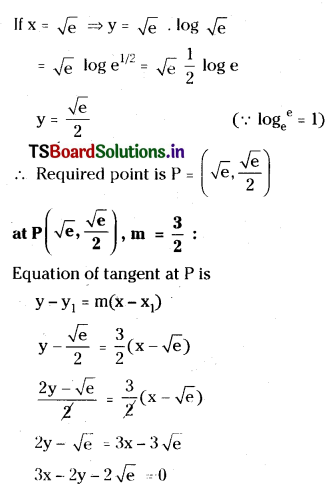
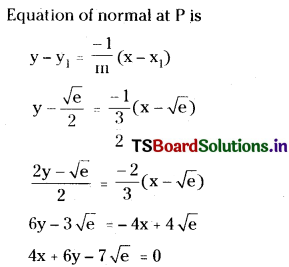
Question 37.
Show that the curves x2 + y2 = 2 and 3x2 + y2 = 4x have a common tangent at the point (1, 1).
Solution:
Given the equation of the first curve is x2 + y2 = 2
Differentiating on both sides with respect to ‘x’
2x + 2y . \(\frac{\mathrm{dy}}{\mathrm{dx}}\) = 0
x + y . \(\frac{\mathrm{dy}}{\mathrm{dx}}\) = 0
y \(\frac{\mathrm{dy}}{\mathrm{dx}}\) = -x
\(\frac{\mathrm{dy}}{\mathrm{dx}}=\frac{-\mathrm{x}}{\mathrm{y}}\)
Slope of the tangent at P(1, 1) is m = \(\left(\frac{d y}{d x}\right)_P=\frac{-1}{1}\) = -1
The equation of the tangent at P is y – y1 = m(x – x1)
y – 1 = -1(x – 1)
y – 1 = -x + 1
x + y – 2 = 0
Given the equation of the second curve is 3x2 + y2 = 4x
Differentiating on both sides with respect to ‘x’

The equation of the tangent at P is y – y1 = m(x – x1)
y – 1 = -1(x – 1)
y – 1 = -x + 1
x + y – 2 = 0
∴ The curves x2 + y2 = 2 and 3x2 + y2 = 4x have a common tangent at the point (1, 1).
![]()
Question 38.
At a point (x1, y1) on the curve x3 + y3 = 3axy, show that the tangent is (\(x_1^2\) – ay1)x + (\(y_1^2\) – ax1)y = ax1y1. [Mar. ’17 (TS)]
Solution:
Given, equation of the curve is x3 + y3 = 3axy ……..(1)
Since P(x1, y1) lies on the curve (1). Then

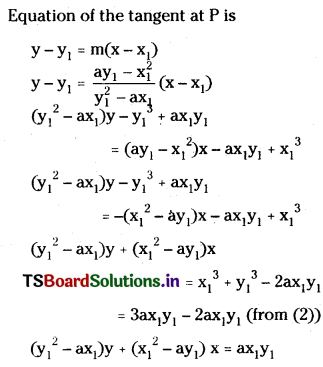
Which is the required equation of tangent.
Question 39.
Show that the length of the subnormal at any point on the curve xy = a2 varies as the cube of the ordinate of the point.
Solution:
Given the equation of the curve is xy = a2
Differentiating on both sides with respect to ‘x’
x . \(\frac{d y}{d x}\) + y . 1 = 0
x \(\frac{d y}{d x}\) = -y
\(\frac{d y}{d x} = \frac{-y}{x}\)
Let P(x, y) be any point on the curve.
The slope of the tangent at P is m = \(\left(\frac{d y}{d x}\right)_P=\frac{-y}{x}\)
Length of the sub-normal = |y1m|

∴ Length of the sub-normal ∝ y3. (Cube of ordinate)
Question 40.
Find the value of k so that the length of the subnormal at any point on the curve xyk = ak+1 is a constant.
Solution:
Given the equation of the curve is xyk = ak+1
Differentiating on both sides with respect to ‘x’

∴ Length of the subnormal at any point is constant then k + 2 = 0
∴ k = -2.
Question 41.
Find the value of k, so that the length of the subnormal at any point on the curve y = a1-k xk is a constant.
Solution:
Given, the equation of the curve is y = a1-k xk
Differentiating on both sides with respect to ‘x’

The length of subnormal at any point is constant then 2k – 1 = 0
2k = 1
k = \(\frac{1}{2}\)
![]()
Question 42.
Find the lengths of sub tangent, and subnormal at a point ‘t’ on the curves x = a(cos t + t sin t), y = a(sin t – t cos t). [Mar. ’17 (TS); May ’15 (TS), ’14]
Solution:
Given that, x = a(cos t + t sin t)
Differentiating on both sides with respect to ‘t’
\(\frac{\mathrm{dx}}{\mathrm{dt}}\) = a[(-sin t) + t(cos t) + sin t (1)]
= a[-sin t + t cos t + sin t]
= at cos t
y = a(sin t – t cos t)
Differentiating on both sides with respect to ‘t’
\(\frac{\mathrm{dy}}{\mathrm{dt}}\) = a[cos t – (t(-sin t) + cos t (1)]
= a[cos t + t sin t – cos t]
= at sin t
\(\frac{d y}{d x}=\frac{\frac{d y}{d t}}{\frac{d x}{d t}}=\frac{\not t \sin t}{\not t \cos t}=\tan t\)
Slope of tangent at any point t is m = \(\left(\frac{d y}{d x}\right)_t\) = tan t
Length of the sub tangent = \(\left|\frac{y_1}{m}\right|\)
= \(\left|\frac{\mathrm{a}(\sin \mathrm{t}-\mathrm{t} \cos \mathrm{t})}{\tan \mathrm{t}}\right|\)
= |a(sin t – t cos t) . cot t|
Length of the subnormal = |y1 . m| = |a (sin t – t cos t) . tan t|
Question 43.
Show that the condition for the orthogonality of the curves ax2 + by2 = 1 and a1x2 + b1y2 = 1 is \(\frac{1}{a}-\frac{1}{b}=\frac{1}{a_1}-\frac{1}{b_1}\). [Mar. ’19 (AP); Mar. ’16 (TS); May ’14]
Solution:
Given, curves are
ax2 + by2 = 1 ……..(1)
a1x2 + b1y2 = 1 ……….(2)
Let the curves intersect at P(x1, y1) then
\(\mathrm{ax}_1^2+\mathrm{by}_1^2=1, \mathrm{a}_1 \mathrm{x}_1{ }^2+\mathrm{b}_1 \mathrm{y}_1{ }^2=1\)
Differentiating (1) on both sides with respect to ‘x’



Question 44.
Find the angle between the curves x + y + 2 = 0 and x2 + y2 – 10y = 0. [Mar. ’14]
Solution:
Given equations of the curves are
x + y + 2 = 0 ………(1)
x2 + y2 – 10y = 0 ……….(2)
From (1), x = -y – 2
Substitute in (2)
(-y – 2) + y2 – 10y = 0
y2 + 4 + 4y + y2 – 10y = 0
2y2 – 6y + 4 = 0
y2 – 3y + 2 = 0
y2 – 2y – y + 2 = 0
y(y – 2) – 1(y – 2) = 0
(y – 2) (y – 1) = 0
y- 2 = 0 (or) y – 1 = 0
y = 2 (or) y = 1
If y = 2, x = -2 – 2 = -4
If y = 1, x = -1 – 2 = -3
Required points are P(-4, 2), Q(-3, 1)
Differentiating (1) on both sides with respect to ‘x’
1 + \(\frac{\mathrm{dy}}{\mathrm{dx}}\) + 0 = 0
\(\frac{\mathrm{dy}}{\mathrm{dx}}\) = -1
Differentiating (2) on both sides with respect to ‘x’

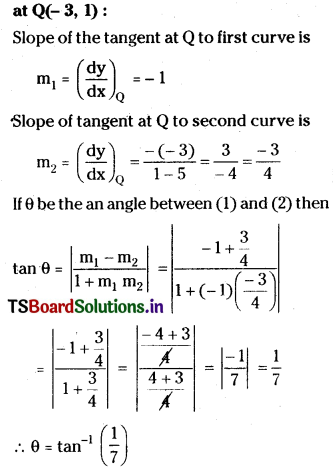
![]()
Question 45.
Find the equation of tangent and normal to the curve y = \(\text { 2. } \mathrm{e}^{-\mathrm{x} / 3}\) at the point where the curve meets the y-axis. [Mar. ’16 (TS)]
Solution:
Equation of the curve is y = \(\text { 2. } \mathrm{e}^{-\mathrm{x} / 3}\)
The equation of the y-axis is x = 0
y = 2
Required point = (0, 2)
Also \(\frac{\mathrm{dy}}{\mathrm{dx}}=\frac{-2}{3} \cdot \mathrm{e}^{\frac{-\mathrm{x}}{3}}\)
and slope m = \(\frac{-2}{3} \cdot \mathrm{e}^{\frac{-0}{3}}=\frac{-2}{3}\)
Equation tangent at p(0, 2) is y – y1 = m(x – x1)
y – 2 = \(\frac{-2}{3}\)(x – 0)
3y – 6 = 2x
2x + 3y – 6 = 0
Equation of the normal is y – y1 = \(\frac{-1}{m}\) (x – x1)
y – 2 = \(\frac{3}{2}\) (x – 0)
2y – 4 = 3x
3x – 2y + 4 = 0